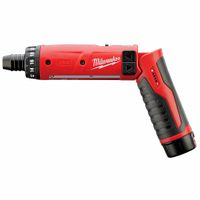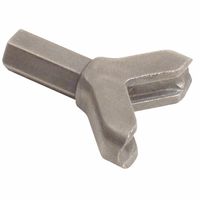Call +(254) 703 030 000 / 751 483 999 / 721 704 777
- Home
- Tools
- Power Tools
- Drills Drivers
- Power Screwdrivers
.....Read More
Frequently Asked Questions
What is the difference between a power screwdriver and a drill?
A power screwdriver and a drill are both essential tools, but they serve different purposes and have distinct features.
A power screwdriver is specifically designed for driving screws. It is typically smaller, lighter, and more compact than a drill, making it ideal for tasks that require precision and control, such as assembling furniture or installing fixtures. Power screwdrivers often have a lower torque and speed, which is suitable for driving screws without damaging the material. They usually come with a clutch to prevent over-tightening and are often powered by rechargeable batteries.
On the other hand, a drill is a more versatile tool used for both drilling holes and driving screws. Drills are generally larger and more powerful, with higher torque and speed settings, making them suitable for a wider range of materials, including wood, metal, and masonry. They can accommodate various drill bits and attachments, allowing them to perform tasks beyond just driving screws, such as drilling holes of different sizes and mixing paint. Drills can be corded or cordless, with cordless models offering greater mobility.
In summary, the main differences lie in their design and functionality: power screwdrivers are optimized for driving screws with precision and ease, while drills offer greater versatility and power for a broader range of tasks.
How do I choose between a corded and cordless power screwdriver?
To choose between a corded and cordless power screwdriver, consider the following factors:
1. **Power Needs**: Corded screwdrivers generally offer more consistent power and torque, making them suitable for heavy-duty tasks. Cordless models are more convenient for light to medium tasks.
2. **Portability**: Cordless screwdrivers provide greater mobility and are ideal for use in areas without easy access to power outlets. Corded models require a power source, limiting their range.
3. **Battery Life**: Cordless screwdrivers depend on battery life, which can be a limitation for extended use. Consider models with long-lasting batteries or quick charging features.
4. **Usage Frequency**: If you use the screwdriver frequently for long periods, a corded model might be more practical to avoid battery downtime. For occasional use, a cordless model offers convenience.
5. **Work Environment**: In tight or awkward spaces, a cordless screwdriver is easier to maneuver. Corded models can be cumbersome due to the power cord.
6. **Cost**: Corded screwdrivers are generally less expensive and have no ongoing battery replacement costs. Cordless models can be pricier, especially with high-capacity batteries.
7. **Maintenance**: Cordless screwdrivers require battery maintenance and eventual replacement, while corded models need less upkeep.
8. **Weight and Ergonomics**: Cordless models can be heavier due to the battery, but advancements have made them more ergonomic. Choose a model that feels comfortable in your hand.
9. **Specific Features**: Look for features like adjustable torque settings, LED lights, and quick-change chucks in both types to suit your specific needs.
Evaluate these factors based on your specific requirements to make an informed decision.
What are the best power screwdriver brands?
Some of the best power screwdriver brands known for their quality, performance, and reliability include:
1. **DeWalt**: Renowned for its durable and high-performance tools, DeWalt offers a range of power screwdrivers that are suitable for both professional and DIY use. Their tools are known for their robust build and long battery life.
2. **Bosch**: A leader in power tools, Bosch provides innovative and efficient power screwdrivers. They are appreciated for their ergonomic design, precision, and advanced technology features.
3. **Makita**: Known for their powerful and compact tools, Makita power screwdrivers are favored for their reliability and efficiency. They offer a variety of models that cater to different needs and preferences.
4. **Milwaukee**: Milwaukee is celebrated for its high-quality, durable tools. Their power screwdrivers are designed for heavy-duty use and are equipped with advanced features for enhanced performance.
5. **Black+Decker**: A popular choice for home use, Black+Decker offers affordable and user-friendly power screwdrivers. They are ideal for light to medium tasks and are known for their ease of use.
6. **Ryobi**: Known for offering good value for money, Ryobi power screwdrivers are suitable for both hobbyists and professionals. They provide a balance of performance and affordability.
7. **Hitachi/Metabo HPT**: Offering a range of reliable and efficient power tools, Hitachi (now Metabo HPT) is known for its innovative designs and high-quality construction.
8. **Craftsman**: Craftsman power screwdrivers are known for their durability and performance. They offer a range of tools that are suitable for various applications.
These brands are recognized for their commitment to quality, innovation, and customer satisfaction, making them top choices for power screwdrivers.
How do I change the bits on a power screwdriver?
1. **Turn Off the Screwdriver**: Ensure the power screwdriver is turned off and unplugged if it's corded, or remove the battery if it's cordless.
2. **Locate the Chuck**: Identify the chuck, which is the part of the screwdriver that holds the bit. It is usually at the front of the tool.
3. **Loosen the Chuck**: If your screwdriver has a keyless chuck, hold the base of the chuck with one hand and turn the front part counterclockwise with the other hand to loosen it. For a keyed chuck, insert the chuck key into the hole on the side of the chuck and turn it counterclockwise.
4. **Remove the Old Bit**: Once the chuck is loosened, pull out the old bit from the chuck.
5. **Select the New Bit**: Choose the appropriate bit for your task. Ensure it is clean and undamaged.
6. **Insert the New Bit**: Place the new bit into the chuck. Make sure it is seated straight and securely.
7. **Tighten the Chuck**: For a keyless chuck, hold the base and turn the front part clockwise to tighten it. For a keyed chuck, use the chuck key to turn it clockwise until the bit is firmly secured.
8. **Test the Bit**: Turn on the screwdriver briefly to ensure the bit is properly seated and does not wobble.
9. **Safety Check**: Double-check that the bit is secure and the chuck is tight before starting your work.
10. **Resume Work**: Once everything is secure, you can resume using the screwdriver for your task.
What maintenance is required for power screwdrivers?
1. **Cleaning**: Regularly clean the power screwdriver to remove dust, debris, and any accumulated dirt. Use a soft cloth and compressed air to clean the vents and other hard-to-reach areas.
2. **Lubrication**: Periodically lubricate moving parts, such as the chuck and gears, to ensure smooth operation. Use a manufacturer-recommended lubricant to avoid damage.
3. **Battery Care**: For cordless models, ensure batteries are charged and stored properly. Avoid overcharging and store batteries in a cool, dry place. Replace batteries when they no longer hold a charge effectively.
4. **Inspection**: Regularly inspect the screwdriver for any signs of wear or damage. Check the power cord for fraying or cuts, and ensure the chuck is functioning correctly.
5. **Tightening Screws**: Check and tighten any loose screws or fasteners on the tool to maintain structural integrity and performance.
6. **Bit Maintenance**: Keep screwdriver bits clean and sharp. Replace worn or damaged bits to ensure efficient operation and prevent damage to screws or work surfaces.
7. **Motor Maintenance**: Listen for unusual noises from the motor, which may indicate a need for professional servicing. Ensure the motor is not overheating during use.
8. **Storage**: Store the power screwdriver in a dry, safe place to prevent exposure to moisture and extreme temperatures, which can damage the tool.
9. **Manual Reference**: Refer to the user manual for specific maintenance guidelines and intervals recommended by the manufacturer.
10. **Professional Servicing**: If the tool exhibits persistent issues or performance drops, consider professional servicing to address internal problems.
How long do the batteries last on cordless power screwdrivers?
The battery life of cordless power screwdrivers varies based on several factors, including the type of battery, the brand, the model, and the usage conditions. Typically, cordless power screwdrivers use either Nickel-Cadmium (NiCd), Nickel-Metal Hydride (NiMH), or Lithium-Ion (Li-Ion) batteries.
1. **Nickel-Cadmium (NiCd) Batteries**: These are older technology and generally have a shorter battery life. They can last anywhere from 1 to 2 hours of continuous use on a full charge. However, they suffer from memory effect, which can reduce their lifespan over time.
2. **Nickel-Metal Hydride (NiMH) Batteries**: These offer a slightly better performance than NiCd batteries, with a typical runtime of 2 to 3 hours. They have less memory effect but still require proper charging practices to maintain longevity.
3. **Lithium-Ion (Li-Ion) Batteries**: These are the most common in modern cordless power screwdrivers due to their superior performance. They can last from 3 to 5 hours of continuous use, depending on the capacity (measured in ampere-hours, Ah) and the power demands of the tool. Li-Ion batteries do not suffer from memory effect and have a longer overall lifespan.
The actual runtime also depends on the power demands of the task. Light-duty tasks will drain the battery more slowly than heavy-duty applications. Additionally, factors such as temperature, age of the battery, and maintenance practices can influence battery life. Regular charging, avoiding complete discharges, and storing batteries in a cool, dry place can help maximize their lifespan.
In summary, the battery life of cordless power screwdrivers can range from 1 to 5 hours of continuous use, with Li-Ion batteries offering the longest runtime and overall lifespan.
Can power screwdrivers be used for drilling holes?
Yes, power screwdrivers can be used for drilling holes, but with limitations. Power screwdrivers are primarily designed for driving screws and may not have the same power or speed as dedicated drills. However, they can be used for light drilling tasks, especially in softer materials like wood, plastic, or drywall.
To use a power screwdriver for drilling, you need to ensure it has a chuck that can accommodate drill bits. Some power screwdrivers come with a hex chuck that can fit hex-shank drill bits. If your power screwdriver has adjustable speed settings, set it to the highest speed for drilling. Additionally, ensure the screwdriver has enough torque to handle the material you are drilling into.
For best results, use smaller drill bits, as larger bits may require more power than a typical power screwdriver can provide. It's also important to apply steady pressure and allow the tool to do the work without forcing it, as this can prevent damage to both the tool and the material.
In summary, while power screwdrivers can be used for drilling small holes in soft materials, they are not a substitute for a dedicated drill when it comes to more demanding tasks or harder materials. For more extensive drilling needs, a power drill or a drill/driver would be more appropriate.


